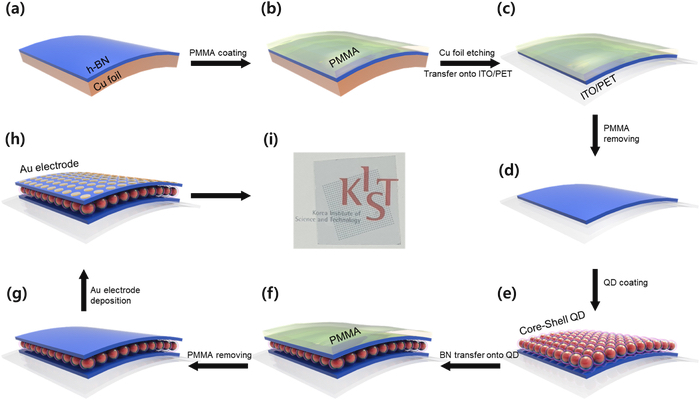Korean team makes transparent flexible 2D memory

Quantum dot and hexagonal BN sandwich holds memory even when flexing
At the Institute of Advanced Composite Materials, Korea Institute of Science and Technology , a research team led by Dong-Ick Son announced the development of a transparent and flexible memory device based on a heterogeneous low-dimensional ultra-thin nanostructure. To this end, monolayered zero-dimensional (0D) quantum dots were formed and sandwiched between two insulating 2D hexagonal boron nitride (h-BN) ultra-thin nanomaterial structures.
The research team made a device that could become a next-generation memory candidate by introducing 0D quantum dots with excellent quantum limiting properties into the active layer, controlling carriers in 2D nanomaterial. Based on this, 0D quantum dots were shaped in a vertically stacked composite structure that was sandwiched between 2D hexagonal h-BN nanomaterials to produce a transparent and flexible device. Therefore, the developed device maintains above 80 percent transparency and memory function even when bent.
The picture above shows: (a-c) hBN transfer to the ITO/PET substrate (d) hBN/ITO/PET substrate; (e) formation of QDs monolayer using a spin-coating technique; (f-g) hBN transfer to the QD/hBN/ITO/PET substrate (h) Au electrode deposition on hBN/QD/hBN/ITO/PET by using a thermal evaporation process; (i) photographs of the device.
Dong-Ick Son stated, "Instead of conductive graphene, by presenting a quantum dot stacking control technology on insulating hexagonal h-BN, we have established the foundation for ultra-thin nanocomposite structure research, and significantly revealed the fabrication and driving principle of next-generation memory devices." He then added, "We plan to systematize the stack control technology for the composition of heterogeneous low-dimensional nanomaterials in the future and expand the scope of its application.“
'Memory effect of vertically stacked hBN/QDs/hBN structures based on quantum-dot monolayers sandwiched between hexagonal boron nitride layer' by Jaeho Shim et al: Composites Part B: Engineering, 2021


































